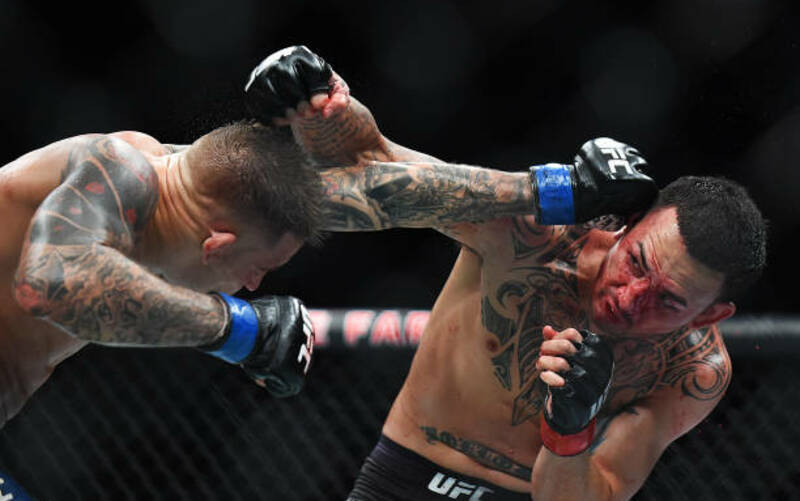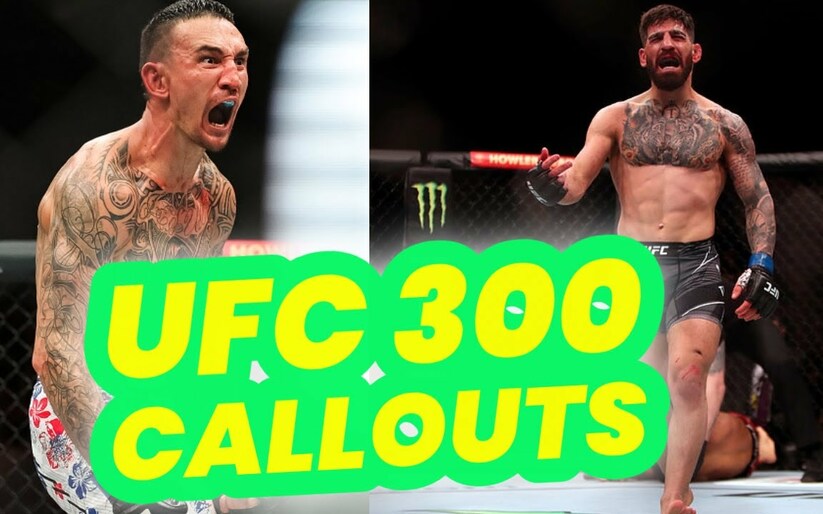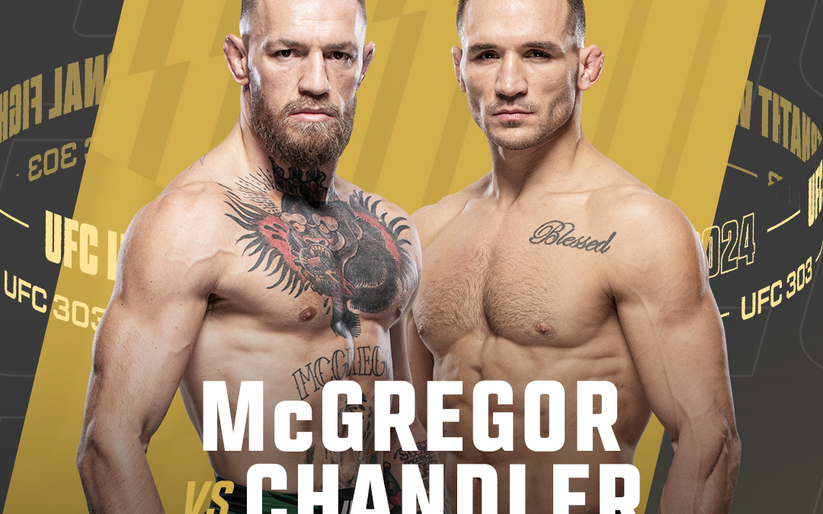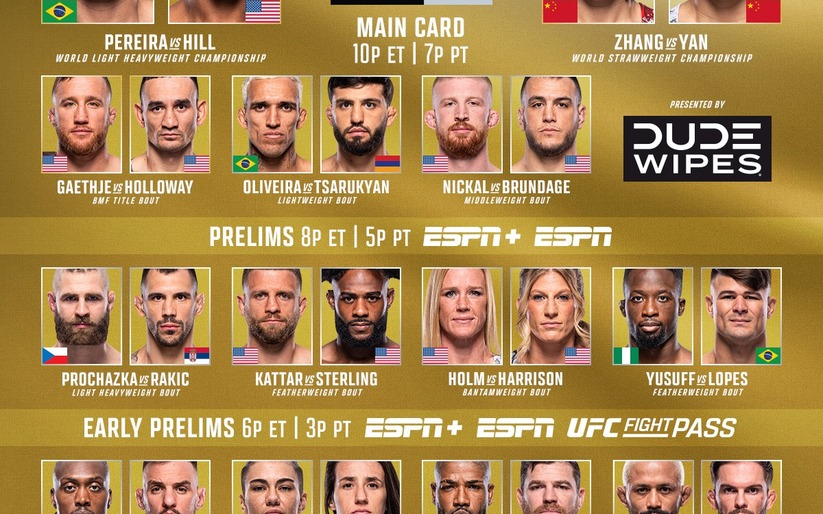The moment Dana White announced that Max Holloway would be fighting Dustin Poirier for the interim UFC lightweight title, voices of anticipation and dread filled the air.
Holloway had a deserved case as the sport’s best fighter, and Poirier had been chipping away at the lightweight elite repeatedly and violently. Pitting the two against each other would undoubtedly be a phenomenal contest, but to see these two beloved fighters set against one another would likely lead to heartbreak. To see either man fall short in such a pivotal contest would be a crying shame.
Fortunately, this was not the case. Dustin Poirier and Max Holloway went strike-for-strike and round-for-round for 25 minutes in one of the sport’s greatest showcases of boxing. In equal parts technical and violent, fans were treated to an absolutely beautiful orchestration of pugilism. Here’s how it happened.
Dustin Poirier vs. Max Holloway 2 Breakdown
War of the Lead Hands
The most obvious challenge that Poirier posed for Holloway was his southpaw stance. In recent outings, Holloway has become more and more reliant on his orthodox stance, and it had been a long time since Max had dealt with a committed southpaw boxer in an open-stance matchup. Poirier’s range and southpaw stance posed immediate threats to the featherweight champion. Immediately, Poirier began attacking Holloway’s lead leg.

>Poirier leads with an overhand left that grazes Holloway’s chin. As Holloway is retreating, Poirier shifts into orthodox, loading up the power in his right leg, and slams Holloway’s lead leg.
Dustin Poirier’s lead hand was arguably the star of the show. As a southpaw, he was able to hand-fight the orthodox Holloway to mitigate the champion’s educated feints and jab.

>Holloway attempts one of his most reliable combinations; a feinted jab into a straight right. As Holloway steps outside of Poirier’s lead foot, Poirier paws at Holloway’s left hand before drawing his right arm across his body and catching Holloway’s right hand on his left forearm.

>Max Holloway paws at Dustin Poirier’s lead hand and attempts a double jab. Poirier pulls his elbow up and ducks behind his shoulder to deflect Holloway’s jab.
Dustin Poirier’s lead hand was used in equally offensive and defensive measures. This was easily the best use of the jab I’ve ever seen in Poirier’s career. Changing both plane and speed of attack, Poirier was able to jab with Holloway to gain the upper hand in many exchanges.

>Poirier and Holloway paw their lead hands. Poirier steps in with a loose body jab. Immediately after, Poirier steps hard with his lead right leg. Holloway folds his arms across his body (a similar response Jose Aldo was able to draw from Holloway), and Poirier staggers him with a flush overhand left. Poirier swarms and lands a hard right hook to the body as Holloway angles off the fence.

>Poirier steps in with a throwaway overhand left, and Holloway retreats to his left side. Dustin Poirier steps through his lead right leg, shifting into orthodox, and runs Holloway into a powerful overhand right. As Max reels, Poirier tosses his left hand out in succession first from orthodox, then shifting back to southpaw, cutting off Holloway’s exit.
Poirier even mixed in shifts and levers into his assault to keep Holloway from creating and sustaining a rhythm.

>Holloway and Poirier stand at trapping range. Poirier steps his lead foot onto Holloway’s foot, and throws an overhand left. Holloway catches the punch on his right forearm and catches Poirier with a pitching left hook counter while pivoting off his lead leg to the outside. Poirier counters Max’s counter with a strong right hook from the inside angle as Holloway is angling out.

>The two men stand in trapping range. Holloway throws a hard right hand to Poirier’s body and slips inside of Poirier’s same-time straight left counter. However, Poirier closes the door with a right hook to Holloway’s chin. Holloway throws a jab, and Poirier doubles up on his right hook as Holloway is attempting to angle out to his left, hurting him.
An argument can be made that Dustin Poirier was the most dimensional offensive threat that Holloway had ever faced. Even the great Jose Aldo maintained a specific slice of range and a specific speed of counter that Holloway tracked into in their rematch. Ortega is violent, but extremely unpolished. Poirier was able to blend leads, counters, and output along with the southpaw threat, which meant that Holloway was adapting at a much slower rate than in previous fights.

>Holloway and Poirier are both standing southpaw. Holloway paws a jab before feinting a jab and following with a wide left hook a half-beat behind it. Poirier reads the feint, pulls off the counter, and intercepts Holloway with a straight left. As Holloway is ducking, Poirier lands a flush lead right uppercut and a tight left hook to Holloway’s chin.
Holloway found a moment of great success with his lead hand, as well. As Poirier was rushing in carelessly, Holloway countered Poirier’s lead right hook with a left hook over the top, catching him, and followed up with a flurry along the fence.

>Holloway’s lead left hook would be a vital weapon in the fight. Poirier throws too much into his right hook, and Holloway’s left hook counter topples him.

>Holloway hops slightly to the outside angle of Poirier’s lead leg and sneaks a left hook behind Poirier’s lead right shoulder. As Poirier is shelling, Holloway lands a straight right down the centerline.

>Holloway marches at Poirier, dragging his lead hand down and levering off his right to cut off Poirier’s exit. You can tell what Poirier was trying to do with his guard in this exchange. This type of shell was optimal for catching and pitching counters. Here, however, he short-arms both punches.
Holloway also switched between the hook and the uppercut with his lead hand.

>Occasionally, Holloway would step deep to the outside and throw a leaping left hook over Poirier’s shoulder.

>The featherweight champion occasionally exploited Poirier’s reactions to punches. Here, he throws a lead uppercut as Poirier is ducking, with a clean straight right follow-up.
Poirier’s defensive guard against Holloway was problematic in certain ways, but largely effective. Utilizing a modified Philly Shell, Poirier was able to hide his chin behind his lead right shoulder while keeping a tight forearm earmuff on his left side. Along with improved head movement and micro movements, Poirier was able to diffuse Holloway’s incredible jab and keep him from dictating the pace of the fight.

>Holloway throws a 1-2 a full beat apart with his lead leg on the outside of Poirier’s lead leg. Poirier shells and frames with his right forearm. In a dirty boxing exchange, Holloway slips Poirier’s tight left hook, but Poirier immediately throws a tight right hook and chains off it into a lead uppercut and then another right hook. Gorgeous.
Holloway would have been better served to have switched to southpaw against Poirier. The assumption is that Holloway got too comfortable fighting his past slew of opponents one way. In his earlier UFC fights leading up to the title, Holloway would switch stances far more often and fight out of southpaw against orthodox fighters (such as Jeremy Stephens and Ricardo Lamas). The closer Max got to the title, the more he began to settle into orthodox while occasionally shifting with marching combinations.
Had Max mirrored Poirier and fought in a closed stance, he would’ve been able to jab with Poirier more freely as well as opening up the tight left hook inside to the head and to the body. Poirier’s guard left the right side of his head vulnerable all night, so Holloway shifting the southpaw could’ve turned his lead left hook into a rear hand power punch.
Turning the Tide
Dustin Poirier’s power differential was helpful in establishing an early lead, but Holloway widening the gap between the two in the later rounds was something most analysts were banking on. In classic ‘Blessed’ fashion, the best work Holloway did all night was to the body. Poirier’s defensive guard prioritized defense to the head, so Holloway started tearing up his ribs.

>Holloway digs a straight right to Poirier’s body. As they circle back to center, Holloway double-feints a jab, each a half beat apart, before slinging a long right hook to Poirier’s body, a full beat later. Holloway sees Poirier’s shell, and throws a left hook while pivoting off to his left. Poirier counters with a cuffing right hook.

>Holloway’s command of rhythm returned in rounds 3 & 4, as well. Here, he feints a double-jab a half beat apart and leaps to the outside. The feints draw the defensive shell from Poirier as well as an attempt to angle off the inside. Holloway pelts him with a hard right hand to the body as Poirier is circling out.

>Something I would’ve liked to have seen a bit more from Max is chaining body kicks into his combinations, since Poirier’s left arm was usually glued to his temple.
Holloway’s discipline in the clinch was also notable. As a relentless grip-fighter inside, Max proved extremely difficult to get to in the clinch for Poirier.

>Holloway enters the clinch on a left hook. With his right arm, he immediately overhooks Poirier’s left arm and controls the right arm of Poirier by pushing down on his forearm. Poirier lands a knee to the body of Holloway without much leverage, but Holloway (standing southpaw) simply raises his right arm and catches Poirier with a tight right hook upon the clinch break.
Some of Holloway’s classic setups were here, including the lead leg feint into southpaw shift.

>This deceiving entry was used to great effect against both Jose Aldo and Anthony Pettis.
What made the third and fourth rounds so rich was Holloway’s adaptability and willingness to change up what wasn’t working. For example, some of Holloway’s best moments were when he counterpunched Poirier, who still occasionally lead with his chin.

>Poirier leads with an overhand left. Holloway hop-steps back and attempts to counter with a double-jab cross. When he feels Poirier out of range, he doesn’t continue to march him down, simply letting the exchange conclude.
Max Holloway is one of the meanest fighters in MMA along the fence. Even with perhaps the best head movement in the sport, Aldo wasn’t able to escape the fence without taking enormous amounts of cumulative body shots. When Ortega, Pettis, and Lamas were trapped along the cage, they were simply annihilated. The fence was the danger zone for Poirier, and it simply wouldn’t be a Holloway fight if the Hawaiian didn’t get a chance to unload along the cage.

>It’s safe to say that Poirier lacks the polished, layered head movement of Jose Aldo, but Holloway also didn’t opt for the body as much as he did against Aldo and Pettis. However, smothering Poirier’s right hook into the clinch knee was a thing of beauty.

>Utilizing the same shifting southpaw entry Holloway was able to force Poirier back into the cage again. In Round 4, Holloway began digging to the body in his extended exchanges as Poirier was wilting. This looked like the beginning of the end for ‘The Diamond.’

>Holloway continued tearing up Poirier’s ribs. Notice that when Poirier grabs a collar-tie with his left, Holloway immediately uses his left arm to create space, fighting grips before framing and landing a knee on the break.
After getting stung and fighting out of a deficit in the first few rounds, Holloway gritted his teeth and forced Poirier to walk through fire for the remainder of Round 4. It made for one of the tensest rounds of the year.

>Poirier has a double-forearm guard up. Holloway traps Poirier’s lead right hand, peeling the guard, and then tosses a throwaway left hook to Poirier’s chin as he leaps to the outside angle. As Poirier is attempting to pivot off his lead leg, Holloway slams another shot to Poirier’s body. Attacking the body on pivots paid dividends for Holloway against one of the best pivoting fighters in MMA in Jose Aldo.
Punishing Holloway’s ducking entries with the clinch was a brutal stroke of genius that left Holloway nearly unrecognizable in a mask of blood.

>As Holloway pressured, he was ducking in on his entries. Poirier grabbed a double collar-tie and cracked the Hawaiian’s face open with a knee.
Despite this, the fight was likely tied up going into the final round.
Making Life Fair
No one has taken the momentum back from Max Holloway. Despite one successful flurry in the third, Ortega was a walking heavy bag for the featherweight champion from bell to bell. Aldo won rounds off of Holloway in both fights but exhausted himself in the process. As soon as Holloway began ramping up his volume, the fight was as good as over. Before that, Holloway had won and/or finished nearly 30 rounds in a row.
While Holloway nabbed the fourth round, the knee Poirier landed was clearly taking a toll on the Hawaiian’s vision. As a result, Poirier stayed behind his jab more and Holloway’s sense of distance weakened.

>Both men stand southpaw. Poirier paws a jab, and Holloway marches in with a lead hook shifting into an orthodox double-jab before shifting back to southpaw. Poirier exits on an angle while shelling, staying safe from all of Holloway’s shots. On the inside, Poirier pops a jab, slips inside of Holloway’s left hook, and catches Holloway’s lead right hook before missing on his own counter hook as Holloway slides back out into range.
Dustin Poirier’s counters remained as sharp as ever.

>When Holloway attempted to needle his way past Poirier’s defense with his jab, he’d often run into Poirier’s cross counter.

>Both standing southpaw, Poirier and Holloway exchanged jabs. Holloway throws an overhand left and Poirier pulls outside of it. To counter, Poirier throws a tight right hook that sails over Holloway’s head. Closing the door, Poirier throws a hard right hook to Holloway’s body with the Hawaiian’s stance compromised.
The more Dustin Poirier countered, the more Max Holloway was forced to simply walk into the buzzsaw again and again. The power differential was a difficult nut for Holloway to crack. Both men were physically compromised by the fifth round, but the layered exchanges proved to be more dire for Holloway than Poirier.

>Poirier paws his lead hand and steps into a jab. Holloway parries it and throws a shifting 1-2 in southpaw. Poirier pulls off the return jab and counters with a check left hook.
To his credit, Holloway continued to press his advantage, putting some extra dig into his body shots and pushing forward, no matter the cost.

>Holloway steps to the outside of Poirier’s lead leg and paws his lead hand down. Throwing several tight hooks inside, his most significant shot in this exchange is the digging left hook to Poirier’s body. Take a look at the posture of both men in this exchange. Poirier is far more erect, whereas Holloway enters the pocket with his knees bent and his head down. As a result, Holloway slips Poirier’s counter right hook before shifting back to southpaw.
It was a dramatic shift, however, from Holloway’s last few fights. Pettis, Aldo, and Ortega all crumbled underneath Holloway’s sheer, unrelenting output. It’s a testament to Poirier’s strategy and discipline that even after two rounds of Holloway surging back into the fight, he stopped the champion from earning the fifth.
Conclusion
Dustin Poirier vs. Max Holloway II is among the rarest of rare fights. Instead of a quick finish or a one-sided domination, two of the sport’s best and more violent fighters engaged in a phenomenal battle of will. Exemplifying both tremendous technical growth and unbelievable grit and determination, Dustin Poirier and Max Holloway lived up to the lofty expectations placed upon them.
Holloway made some strategic errors against Poirier that cost him early, and his slower rate of adaption meant that he had a much wider gap to close after his opponent’s early success. The lack of going southpaw and being thrown off his game due to Poirier’s power cost him in the end, and Holloway still had an argument to winning this fight. It’s a testament to the Hawaiian’s toughness, output, and enormous depth of skill that he can be thrown off his initial gameplan and still put forth a winning effort. Whether a return to featherweight or a continued run at lightweight is in his future, Max Holloway once against proved himself to be one of the best in MMA.
For Dustin Poirier, he netted one of the finest wins in MMA history and (in the opinion of this writer) cemented himself as an all-time great lightweight. For a fighter who had broken through every ceiling that had ever been placed upon him, UFC 236 was a culmination of a career filled with blood, grit, and courage. It’s impossible to look back on Poirier’s UFC career and not feel inspired. Up next for the interim champion is undoubtedly a bout with Khabib Nurmagomedov, and to me, Dustin Poirier has as good a chance as any to knock the champion off his perch.
At this moment in time, however, none of that matters. What matters is that everyone who tuned in for UFC 236 appreciates the brilliance that these two valiant men put forth. 2019 found its Fight of the Year, and it’s Dustin Poirier vs. Max Holloway II.
Main Photo
Embed from Getty Images



